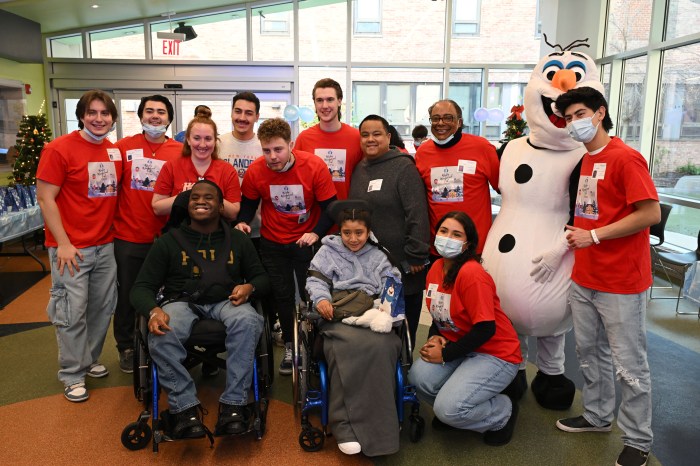John Golden, owner and operator of Martin A. Gleason Funeral Homes, said their funeral homes in northeast Queens never had to turn families away — then came COVID-19.
“We don’t have the capacity to handle all the families that are calling us,” Golden told QNS. “We’ve served double the normal amount of families we serve in a month. At one point, we had to turn 100 families away.”
But the Gleason Funeral Homes — with locations in Flushing, Bayside and Whitestone — are far from the only funeral homes in New York City dealing with an influx of families and their deceased loved ones due to the novel coronavirus.
Although COVID-19 is believed to have reached its peak, funeral homes, crematoriums and cemeteries are still dealing with great volumes of families needing funeral arrangements as New York City’s death toll reaches almost 13,724 confirmed deaths to the coronavirus and 5,383 probable deaths, as of Tuesday, May 5, according to the Department of Health.
The city and state implemented some ways to help the mortuary system — such as setting up mobile morgues and allowing crematoriums to work around the clock — but the industry is still adjusting to the devastating losses.
The Gleason Funeral Homes funeral directors go where the deceased are, which can be in refrigerated trailers outside of hospitals, hospital morgues, houses and nursing homes.
Golden said the medical examiner has a new system that lets them know where the deceased are, but, he added, “Everything has slowed up and become more difficult.”
He said that their funeral homes offer embalming, which allows them to safely hold deceased bodies until burial in the absence of a refrigerator.
But Gleason Funeral Homes, which has served Queens for over 100 years, have limited their number of funerals, as they try to keep from overwhelming and overextending staff members. Golden said that one day, a secretary had to turn away a family, and as soon as she got off the phone, she couldn’t help but cry.
“This has taken an emotional toll on all our staff at Gleason Funeral Homes, but we’re still working to send off the deceased and their families as best we can,” Golden said.
And for families, the grieving process has become even more of a challenge.
Right now, there are no wakes at Gleason, and cemeteries have limited visits to 10 people. Crematories currently are not allowing visitations. Some have allowed grave site recordings to send to families with their permission.
Golden said they were able to record graveside prayers for a nun who passed away to send to her convent.
He mentioned there are some Catholic churches in the area conducting memorial masses virtually, where there’s no one in the church except the priest so families can access it online. In one instance, St. Andrews in Flushing had a priest go outside of the church and bless the casket from the car.
But Golden said it’s still a very difficult situation for families who weren’t able to see their loved one in the hospital, and can’t have a ceremony.
Several weeks ago, the city was only holding deceased for 48 hours before burying “unclaimed” bodies on Hart Island, which Golden said caused families to feel “panic.”
“We were able to intercept some, and now the medical examiner has extended the hold indefinitely,” he said.
But Golden said the system as a whole is still “backed up.”
Many of the cemeteries they work with have limited burial times and visitations. For instance, the next available date for a burial at Mount St. Mary Cemetery in Flushing is May 25.
St. Michael’s Cemetery in East Elmhurst temporarily closed visitation and is restricting internments attendance in order to protect their staff.
Golden said they previously wrote letters asking Gov. Andrew Cuomo to let out-of-state funeral directors come and help, which Cuomo did in the first week of April.
That has helped, Golden said, but now he thinks cemeteries may need help getting workers or independent contractors to open grave sites.
Golden said he suggested the city bring in military embalmers with experience handling deceased bodies and set them up in Flushing Meadows Corona Park, along with the out-of-state funeral directors. He believes more help caring for those who have died due to COVID-19 may lessen the burden.
Public Advocate Jumanee Williams recently sent a letter to New York State Health Commissioner Howard Zucker calling for Section 4144 of New York State Law — requiring that all bodies be removed by a licensed funeral director — be temporarily exempted or amended to allow any paid employee of a funeral home to perform body removal.
Williams argued the measure would vastly increase funeral homes’ capacity to empty the city’s overcrowded hospitals and morgues.
“With this change in place, more families would be granted the dignity of giving their loved ones an individual burial, and strain upon our hospitals and morgues would be reduced,” Williams wrote in the letter.
But Golden believes that it’s better to have licensed funeral directors removing bodies, especially when dealing with a contagious disease like COVID-19.
“You don’t want someone who isn’t OSHA trained doing this,” he said. “You need a licensed funeral director because they know how to pick up the deceased. You have to make sure you get the right deceased body as well.”
He said the problem, again, is that the system is backed up, not that there aren’t enough funeral directors.
Golden, who’s worked as a funeral director for more than three decades, said the amount of death they’re experiencing only compares to 9/11 — but it’s much harder to navigate the current health crisis.
“In normal times, the most gratifying thing was shepherding families through the steps as they mourn — accompanying them to crematories, helping them grieve,” Golden said. “And then COVID-19 arrived.”




































